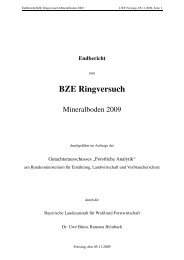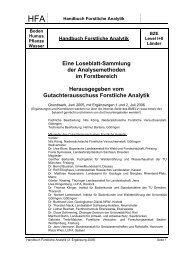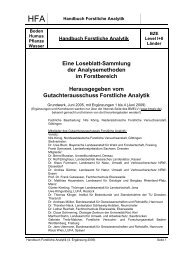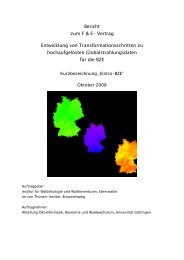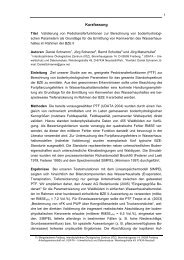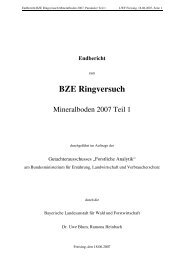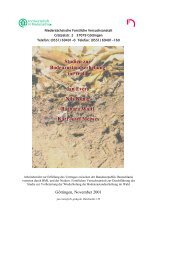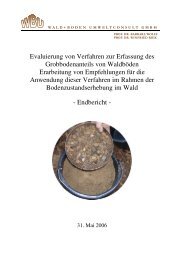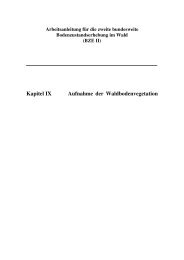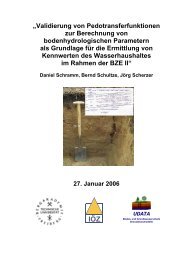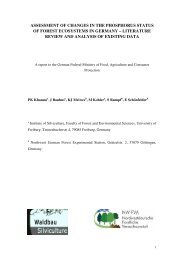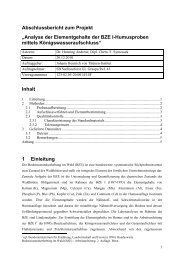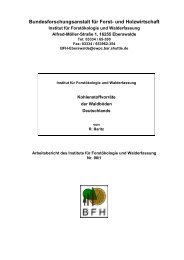assessment of changes in the phosphorus status of forest ...
assessment of changes in the phosphorus status of forest ...
assessment of changes in the phosphorus status of forest ...
Create successful ePaper yourself
Turn your PDF publications into a flip-book with our unique Google optimized e-Paper software.
3. PHOSPHRUS IN FOREST SOILS<br />
3.1 Introduction<br />
Phosphorus occurs <strong>in</strong> many <strong>in</strong>organic and organic forms <strong>in</strong> soils, but P is taken up by<br />
roots from <strong>the</strong> soil solution phase <strong>in</strong> <strong>the</strong> phosphate forms. The amount <strong>of</strong> phosphate <strong>in</strong><br />
soil solution is commonly very low, which results from dynamic equilibrium between<br />
dissolution and precipitation processes <strong>of</strong> <strong>in</strong>organic P forms, m<strong>in</strong>eralisation and<br />
immobilisation <strong>of</strong> organic P forms and uptake by plant roots. Fig 11 describes <strong>in</strong> short<br />
<strong>the</strong> conceptual frame work <strong>of</strong> P dynamics <strong>in</strong> soils. The P concentration <strong>in</strong> soil solution<br />
determ<strong>in</strong>es <strong>the</strong> amount <strong>of</strong> P taken up by roots and mycorrhiza. It is described as <strong>the</strong><br />
<strong>in</strong>tensity factor determ<strong>in</strong><strong>in</strong>g <strong>the</strong> uptake and o<strong>the</strong>r adsorption and desorption processes.<br />
Low concentrations <strong>of</strong> P <strong>in</strong> <strong>the</strong> soil solution, which may be <strong>the</strong> result <strong>of</strong> k<strong>in</strong>etics <strong>of</strong><br />
desorption reactions, would reduce P uptake by roots. On <strong>the</strong> o<strong>the</strong>r hand, high P<br />
concentrations <strong>in</strong> <strong>the</strong> solution phase, which may occur follow<strong>in</strong>g P fertilization, would<br />
lead to adsorption processes, <strong>in</strong>itially <strong>in</strong> <strong>the</strong> readily labile forms which <strong>the</strong>n move <strong>in</strong>to<br />
moderately or spar<strong>in</strong>gly soluble forms. The moderately and spar<strong>in</strong>gly soluble forms<br />
are also <strong>in</strong> equilibrium with <strong>the</strong> occluded forms, though many <strong>of</strong> <strong>the</strong>se reactions have<br />
very slow k<strong>in</strong>etics. In addition, P bound <strong>in</strong> secondary and primary m<strong>in</strong>erals may also<br />
become available through wea<strong>the</strong>r<strong>in</strong>g reactions mostly <strong>in</strong>volv<strong>in</strong>g protons and<br />
complex<strong>in</strong>g agents produced by plants and microbes. Phosphorus taken up by <strong>the</strong><br />
plants is partly reverted to organic P forms, which may rema<strong>in</strong> <strong>in</strong> labile forms or be<br />
protected from fur<strong>the</strong>r m<strong>in</strong>eralisation. M<strong>in</strong>eralisation <strong>of</strong> organic P is carried out by<br />
enzymatic reactions through phosphatases. Production <strong>of</strong> phosphatases is related to<br />
root activities and <strong>the</strong> concentration <strong>of</strong> P <strong>in</strong> <strong>the</strong> solution or labile forms. Therefore,<br />
plants play an important role <strong>in</strong> P dynamics <strong>of</strong> soils, especially <strong>in</strong> <strong>forest</strong> ecosystems.<br />
In agricultural systems, where plants need high amounts <strong>of</strong> P over a short grow<strong>in</strong>g<br />
period, contributions to <strong>the</strong> supply <strong>of</strong> P by m<strong>in</strong>eralisation <strong>of</strong> organic P is commonly<br />
considered to be <strong>of</strong> low significance. However, <strong>in</strong> surface layers <strong>of</strong> <strong>forest</strong> soils,<br />
organic P may form <strong>the</strong> dom<strong>in</strong>ant fraction <strong>of</strong> P <strong>in</strong> most cases, but <strong>the</strong> amount and rate<br />
<strong>of</strong> its m<strong>in</strong>eralisation have been rarely studied. Harrison (1982) argued that ow<strong>in</strong>g to<br />
<strong>the</strong> high amount <strong>of</strong> organic P <strong>in</strong> <strong>forest</strong> soils, m<strong>in</strong>eralisation <strong>of</strong> a small fraction <strong>of</strong> about<br />
1% <strong>of</strong> organic P <strong>in</strong> <strong>the</strong> surface 5 cm depth layer would supply sufficient P for annual<br />
uptake. Bauhus and Khanna (1999) reported <strong>in</strong> <strong>the</strong>ir review about microbial biomass<br />
<strong>in</strong> <strong>forest</strong> soils that microbial P can account for 13% to 23% <strong>of</strong> total P <strong>in</strong> <strong>the</strong> m<strong>in</strong>eral<br />
soil and <strong>forest</strong> floor layer respectively. Nutrients <strong>in</strong> microbial biomass are considered<br />
49



